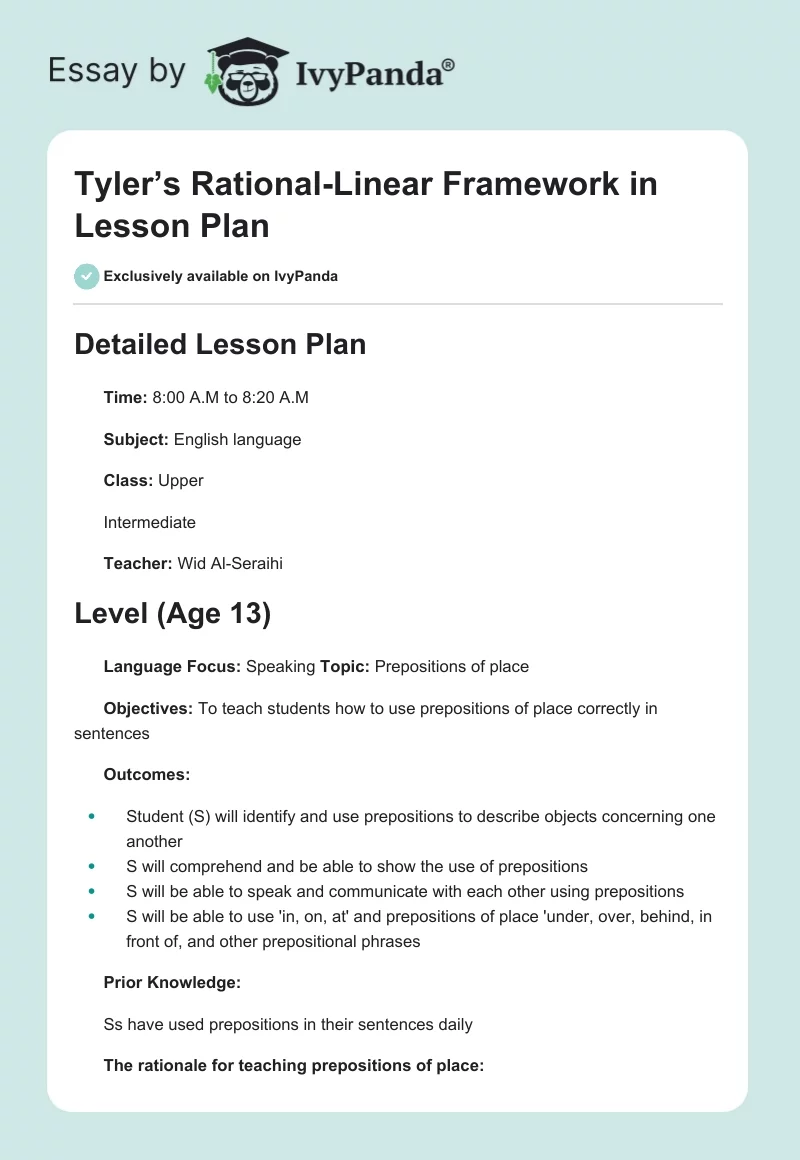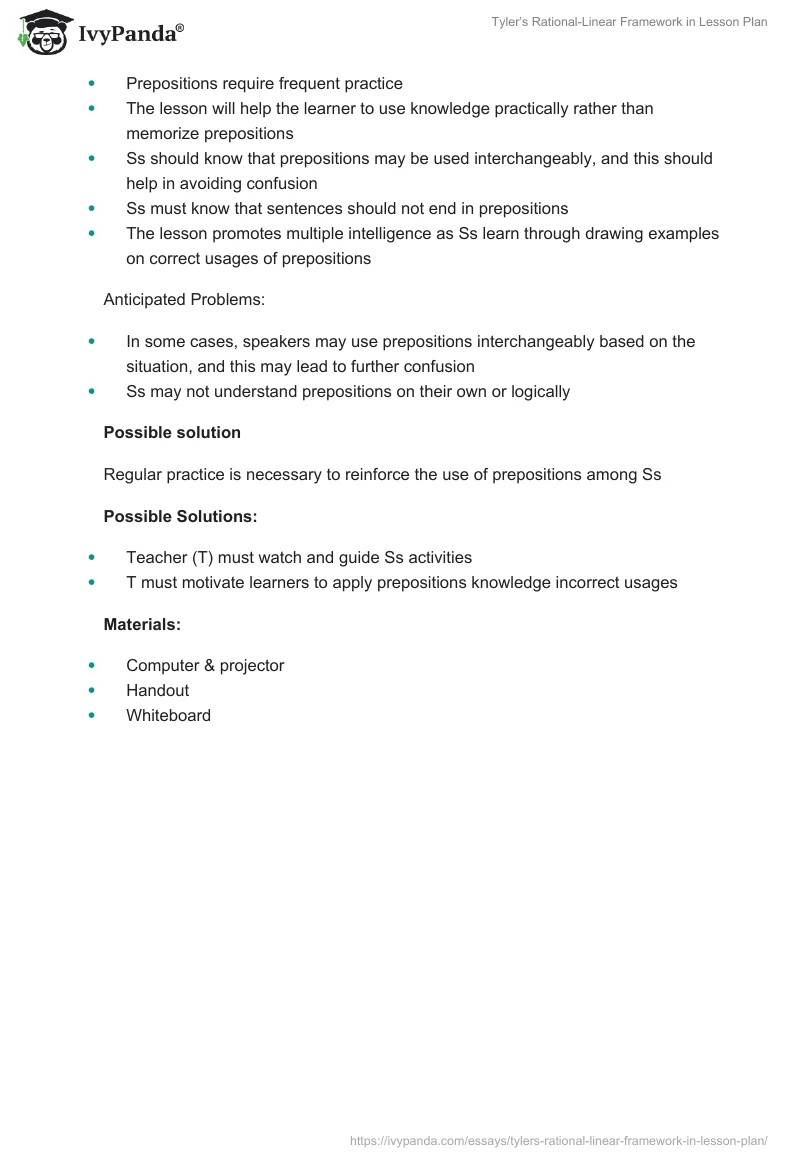Detailed Lesson Plan
Time: 8:00 A.M to 8:20 A.M
Subject: English language
Class: Upper
Intermediate
Teacher: Wid Al-Seraihi
Level (Age 13)
Language Focus: Speaking Topic: Prepositions of place
Objectives: To teach students how to use prepositions of place correctly in sentences
Outcomes:
- Student (S) will identify and use prepositions to describe objects concerning one another
- S will comprehend and be able to show the use of prepositions
- S will be able to speak and communicate with each other using prepositions
- S will be able to use ‘in, on, at’ and prepositions of place ‘under, over, behind, in front of, and other prepositional phrases
Prior Knowledge:
Ss have used prepositions in their sentences daily
The rationale for teaching prepositions of place:
- Prepositions require frequent practice
- The lesson will help the learner to use knowledge practically rather than memorize prepositions
- Ss should know that prepositions may be used interchangeably, and this should help in avoiding confusion
- Ss must know that sentences should not end in prepositions
- The lesson promotes multiple intelligence as Ss learn through drawing examples on correct usages of prepositions
Anticipated Problems:
- In some cases, speakers may use prepositions interchangeably based on the situation, and this may lead to further confusion
- Ss may not understand prepositions on their own or logically
Possible solution
Regular practice is necessary to reinforce the use of prepositions among Ss
Possible Solutions:
- Teacher (T) must watch and guide Ss activities
- T must motivate learners to apply prepositions knowledge incorrect usages
Materials:
- Computer & projector
- Handout
- Whiteboard
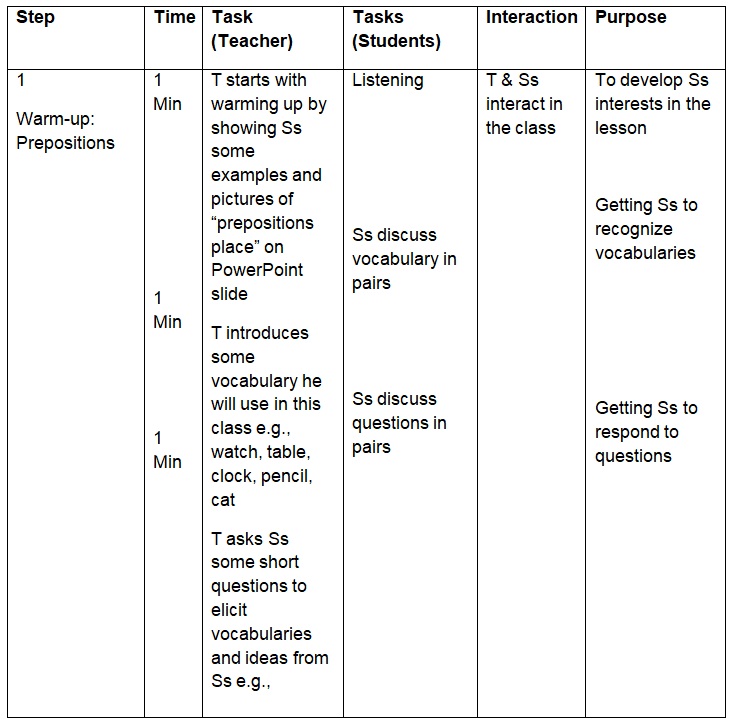
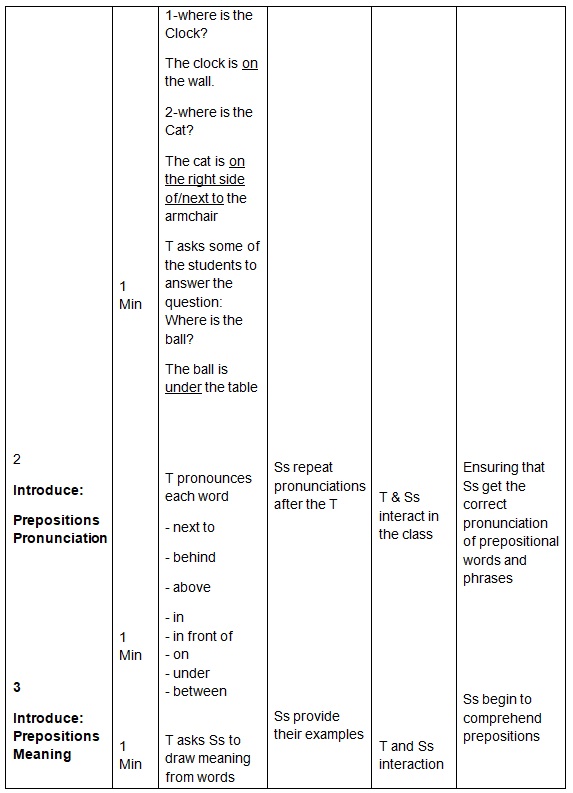
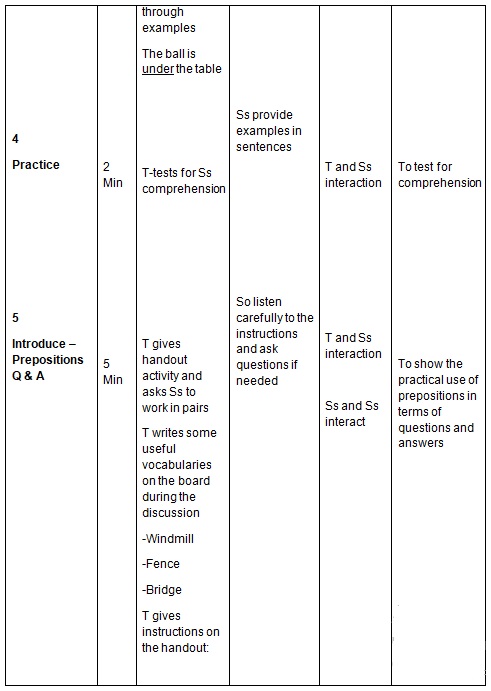
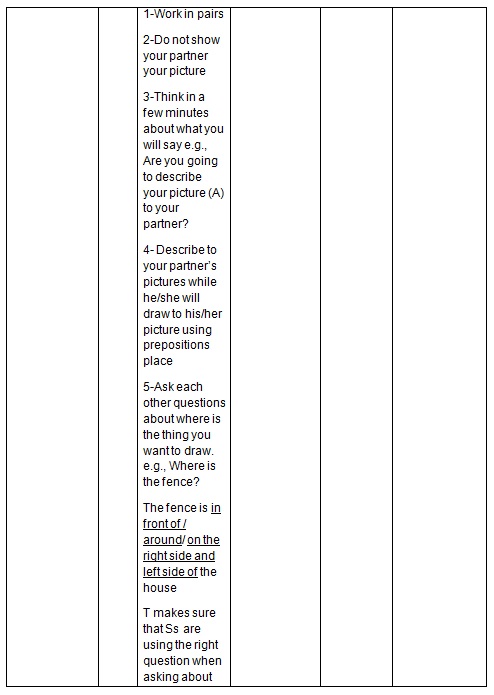
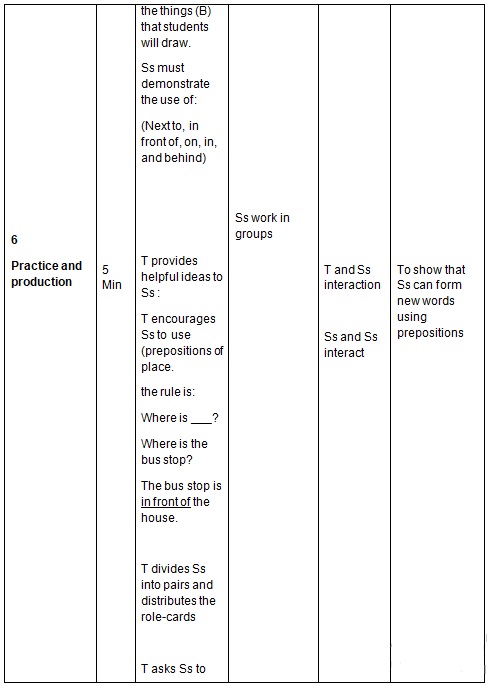
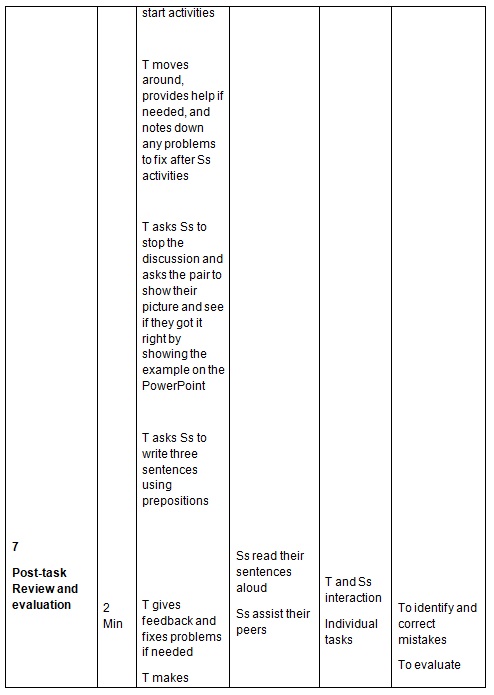
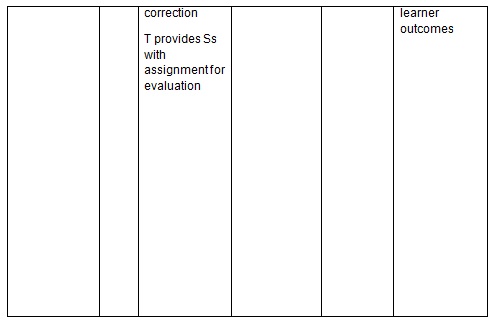
Self-Evaluation of Lesson
What worked?
Students were able to pronounce vocabularies correctly, form their sentences, and draw examples from pictures presented
Students showed prior knowledge in the use of basic prepositions. This made the examples easy to formulate.
Why did it work?
Ss are familiar with some elements of prepositions in daily usages of language.
Ss had prior knowledge about basic prepositions and could guess their meanings and usages
What did not work?
Ss were not able to apply prepositions with phrases correctly
Why it did not work?
Prepositional phrases were a bit complex to Ss due to changes in usages based on different situations. Thus, the confusion was inevitable.
What I would do next time (if I had the opportunity to teach the lesson again)
Provide adequate time for students to practice as I identify mistakes for correction and provide students with opportunities to correct their peers
Comment
Teachers should teach prepositions throughout the course to enhance practical usages
Students should practice with new complex sentences
Students must learn prepositions throughout their courses
Rationale
Model of the Lesson Plan used
The teacher based the prepositions of the place lesson plan on Tyler’s Rational-Linear Framework. The teacher used this model because it provided an opportunity to identify four stages that occur in a sequence during lesson planning. Tyler’s Rational-Linear Framework has four steps, which the teacher found out that were easy to follow (Farrell, 2002):
- Specify objectives
- Select learning activities
- Organize learning activities
- Specify methods of evaluation
Studies have shown that Tyler’s model of lesson planning is the most common and widely used among teachers (Farrell, 2002). The teacher used this model carefully to design a lesson plan for prepositions of place because some studies have shown that teachers rarely followed the sequential steps Tyler provided in his model (Yinger, 1980). A study by Tyler regarding what teachers did when they were planning lessons established that teachers mainly focused on “interests and needs of their students” (Taylor, 1970).
The teacher believed that Tyler’s linear model of a lesson plan for prepositions of place would help him to present the lesson in a sequence and avoid deviation, if necessary. Further studies also indicated that many English teachers tended to depart away from the original design of a lesson plan when teaching. Also, teachers did not consider learner behaviors in their daily lesson plans. However, this lesson plan had to account for learner behaviors. The teachers planned this lesson plan in terms of orders of activities, teaching programs, schedules, and with aim of focusing on the needs of learners (Farrell, 2002).
Tyler’s model is flexible to allow the teacher to deviate from the original prepositions of the place lesson plan to accommodate other needs of learners. The teacher will aim to follow the lesson plan of prepositions of place as planned. However, if he deviates, then the teacher would aim to serve a general need among students while teaching prepositions of place. This will take place in a situation where students will raise concerns. The teacher may then consider the issue as important. This prompts the teacher to deviate from the original lesson plan.
The teacher also would deviate from the prepositions of the place lesson plan to teach some unplanned events e.g., tense. In this regard, a teacher will consider such events important and timely for the class even if they are not part of the lesson plan. Bailey also claimed that teachers would abandon their lessons to teach further. In this case, teachers would adjust his lesson plan as the class progress when teaching prepositions of place. The teachers would depart from the original lesson plan to “accommodate student’s learning styles” (Bailey, 1986). This will take place in a case where the original lesson plan will not cater to the needs of such learners in prepositions of place. The teacher would also deviate from their original lesson plans to enhance learners’ involvement in the lesson through direct activities.
Bailey’s observations indicate that a teacher’s decision-making process is dynamic and may not conform to the planned lesson because of classroom dynamics, lesson complexity, and learners’ characteristics.
Objectives of the Lesson
The major aim of this lesson was to teach students how to use prepositions of place correctly in sentences. The teacher wanted to teach students how to use prepositions of place correctly in their sentences.
An effective lesson plan must indicate what the teacher plans to accomplish at the end of the lesson. The teacher shows this through “appropriate and clearly written objectives” (Farrell, 2002). The objective provides learning outcomes, as well as what the teacher would like students to know at the end of the lesson. Thus, a written objection is the fundamental basis of any lesson plan. An objective must clearly show what students will achieve at the end of the lesson, highlight the general aim of the lesson, and show activities and procedures, which can lead to the achievement of expected learning outcomes. It will also provide the teacher with an opportunity to assess the lesson, know what is next, and prepare students appropriately.
One major issue that a teacher must understand is the objective of the lesson. In other words, teachers must understand the importance of writing a lesson plan for every class. It is also necessary to note that different teachers have devised various methods of planning a lesson. While other teachers may have detailed lesson plans, others may simply have lesson plans in their minds. Thus, one may wonder about the importance of a lesson plan to a teacher or the necessity of developing a lesson plan. In most cases, teachers may develop a lesson plan as a way of meeting supervisory roles. The majority of teachers understand the essence of a lesson plan. In this regard, the lesson plan would assist the teacher to meet his plans of teaching prepositions of place and allow learners to apply the same in practical sentences. A lesson plan assists the teacher by presenting what learners will cover in a lesson for a given duration. For instance, in this lesson plan, the teacher defined the lesson objectives, identified expected outcomes, areas of challenges, and possible solutions. Also, the teacher performs self-evaluation to determine whether the lesson was successful or not. Further, he provides comments on the lesson on what should happen in the subsequent classes.
Overall, a lesson plan can assist the teacher to focus on the lesson content, schedules, class activities, sequencing, and materials for the class. Under some circumstances, a lesson plan guides the teacher in dynamic classroom situations. It also serves as a record of what learners have covered in the course. A developed lesson plan must benefit learners because it accounts for different learner characteristics, backgrounds, learning abilities, and teacher teaching styles.
Activities and Procedures to help learners meet the lesson objectives
Michael Grenfell provides effective insights on teaching language in the context of second language learning (Grenfell, 2007). In the lesson plan, the teacher aims to promote ‘good language’ learning. Consequently, the teacher based the lesson plan on the needs of students. In this regard, he included the following activities and procedures.
- These learners are not native speakers of English. Thus, after preparation for the lesson in prepositions of place, the teacher would introduce pronunciation of all listed prepositions of place. Joan Morley notes that there is not much about pronunciation (Morley, 1991). However, it is an important element in the teaching of the English language. As a result, it has remained a priority for teachers as they strive for accuracy and correct grammar. As learner characteristics change, teachers have focused on the specific needs of every learner in their instructional programs. Thus, the teacher needs to ensure that learners can pronounce all prepositions of place accurately. However, there are debates regarding the importance of pronunciation. Teachers must recognize that learners may change their pronunciation patterns due to a specific teaching approach. Thus, there is a need to get the right pronunciation in a second language classroom.
- Participation among learners, practice on the use of prepositions of place, and encourage students to use the language daily. Based on the concept of ‘good language learner’ strategy, the above lesson plan reflects the best approach to teaching English as a second language.
- It has pedagogical interests of learners and the teacher as shown by the interaction between the teacher and students (Celce-Murcia, 1991). The teacher aimed to present a lesson plan that would result in successful learning and positive learning outcomes.
- The lesson plan shows “active task approach by the teacher and students, realisation of prepositions of place as a means of communication and monitoring performance” (Grenfell, 2007).
- The teacher would apply grammar learning, vocabulary, listening, writing, talking, and reading when teaching prepositions of place (Grenfell, 2007). Brown shows that there are differences between learning first and second languages. Thus, the teacher must approach the second language learning carefully because of learners’ diversity (Brown, 2000).
- The teacher also included a self-evaluation report and proposed ways of improving the lesson on areas of weaknesses.
Implementing the Lesson Plan
After developing a lesson plan, the next stage involves implementing it. Teachers and educators agree that implementing a lesson plan is a critical and challenging stage in planning a lesson. The teacher shall implement the lesson plan for prepositions of place using the following steps:
First, the teacher will review the entire lesson plan to ensure that it has all the required sections for teaching prepositions of place. The teacher will ensure that the lesson plan has the following parts.
Objectives
- Study level
- Learning outcomes
- Difficulties and solutions
- Learners’ evaluation
- Self-evaluation for the teacher
These are fundamental contents of a lesson plan, which a teacher must review before implementing the plan.
Second, the teacher would collect all the required materials for teaching prepositions of place based on the lesson plan. The teacher will ensure that students get adequate practice and draw their sentences.
Third, the teacher will follow the steps as outlined in the lesson plan. Hence, he must account for any deviation.
Fourth, the teacher will engage learners in constant interactions to obtain lesson feedback during the learning process.
Finally, the teacher would provide time for questions, evaluation, and correction among peers. The teacher must encourage students to ask about usages of prepositions they do not comprehend.
Anticipated Problems
- In some cases, students may use prepositions interchangeably based on the situation, and this may lead to further confusion
- Students may not understand the use of prepositions on their own or logically
- Different learner characteristics
- External interruptions
Possible Solutions
A teacher may abandon the lesson plan as he faces classroom difficulties and realities. Besides, a classroom has several cases of unplanned occurrences, which may distract the entire class and the teacher from the lesson plan. In this case, the teacher must uphold the original idea of the lesson plan, intentions, objectives, students’ abilities, and competence. However, if the teacher discovers that there are challenges in the implementation phase of the lesson plan, then he may adjust it to meet unique learner behaviors and characteristics (Farrell, 2002).
The teacher needs to depart from the original lesson plan and make changes to accommodate new development in the classroom. An experienced teacher can easily recognize when there are challenges in the classroom because of the lesson. However, this is not the case with new teachers. A teacher needs a contingency plan as a way of managing unexpected classroom outcomes. This requires sufficient knowledge and experience because it might be difficult to depart from a lesson plan when teaching is in progress.
The challenge with the effective implementation of a lesson plan is that no teacher can predict the outcome of a lesson before implementing the lesson plan itself. In some cases, the interruption may also come from outside the classroom. A lesson plan does not account for such interruptions. However, the teacher must formulate ways of handling such interruptions and complete the lesson within the schedule.
Experienced teachers have professional knowledge of implementing a lesson plan successfully. Effective implementation of a lesson plan requires a teacher to observe two critical aspects. Farrell notes that these are “lesson variety and lesson pacing” (Farrell, 2002). A lesson variety aims to keep the class lively, interesting, and active as students and the teacher interact in many ways. Variation in a lesson should involve the use of speed in the presentation. The teacher should also consider different activities when implementing a lesson plan. These may include group works, pair work, individual tasks, and full class participation (Farrell, 2002).
The level of classroom activities should also differ from difficulties. The teacher must use both easy and difficult tasks when implementing a lesson plan. Such tasks can arouse interest in students. In this regard, the teacher must apply student-centered learning so that the learner becomes the center of learning. According to Ur, teachers should not “fling together activities in random order because this would result in restlessness and disorder” (Ur, 1996). On this note, Ur notes that teachers should introduce technical activities earlier in the lesson. However, the teacher must try various strategies to identify an effective method of implementing a lesson plan.
The teacher should observe lesson pacing. This relates to the progress and timing of the lesson. According to Brown, a teacher can develop a sense of lesson pacing under certain guidelines (Brown, 1994). First, lesson plan activities should not be either too short or too long. Second, strategies for implementing a lesson plan should be in harmony with each other. Third, the teacher must demonstrate a clear shift from one activity to another. The teacher must implement the lesson plan to meet the needs of learners rather than his own.
Evaluating the success or failure of the Lesson Plan
Evaluation is the last part of lesson planning, which involves reviewing failures or success of the lesson. Brown notes that the evaluation process can take place during or after the lesson has ended (Brown, 1994). Ur believes that it is necessary to ask learners about the outcome of a lesson. This would allow the teacher to understand the success or failure of the lesson plan. There must also be adequate explanations for either success or failure of the plan. This reflection serves the purposes of self-development for the teacher. The teacher must note that failure and success are factors, which depend on an individual’s perspective. Thus, their definitions will vary significantly. A teacher who fails to conduct self-assessment and student evaluation have no method of knowing lesson outcomes. Consequently, he may not identify areas of success, weaknesses, and cases that need improvement. According to Brown, evaluation can be formal or informal in lesson planning as a form of assessment (Brown, 1994). The teacher can make an effective evaluation after learning has taken place. The teacher should consider the following criteria for effective evaluation of the lesson plan for prepositions of place.
- Indicators that students are learning the content well
- Students used prepositions of place in their sentences throughout the lesson
- Students remained alert throughout the lesson
- Students participated in the lesson and showed enthusiasm
- Students were active during the lesson
- The teacher did not deviate from the lesson plan
- The teacher and students maintained interaction throughout the lesson
The teacher may adjust evaluation criteria based on his preferences. After the lesson, the teacher must conduct a self-assessment and note the following:
- Student learning outcomes
- Most successful learning activities
- Least successful learning activities
- Causes of success or failure
- Time management during the lesson
- Potential changes to the lesson plan, if any
Besides, the teacher should also get learners’ opinions regarding the lesson. He may wish to ask some questions to students at the end of the lesson. Such responses should aid the teacher in preparation for the next lesson.
- Students should provide their thoughts about the lesson
- Complex activities and simple ones
- Changes the teacher should implement for the next class
The teacher will focus on student learning outcomes when evaluating a lesson plan. This is the most important indicator of any lesson outcomes because the teacher designed the lesson plan based on student-centered learning. According to Ur, the teacher can guess outcomes of a lesson plan through “knowledge of the class, the type of activity they were engaged in, and some informal test activities that give feedback on learning” (Ur, 1996).
The teacher must allow students to close the lesson by providing a summary of the lesson learned. It is the responsibility of the teacher to initiate this process as a way of evaluating and recapping the lesson. The teacher may ask learners to perform some oral presentations and individual tasks.
This lesson plan provides the teacher with a guide on how to teach prepositions of place to intermediate level students, who are learning English as their second language. The teacher must ensure that the core elements of the lesson plan are clear. It is the lesson plan, which gives the teacher direction, makes learning purposeful, and lets students engage in learning. Thus, a teacher should not develop a lesson plan to meet administrative conditions only.
The teacher must be careful with the implementation of a lesson plan. Effective implementation can result in successful teaching and learning. However, the teacher must note that he may depart from the original lesson plan under some circumstances. Finally, the evaluation of students and self-assessment for the teacher should provide the teacher with the outcome of the lesson. Thus, he can identify areas for improvement for future lessons.
References
Bailey, K. M. (1986). The best-laid plans: Teachers’ in-class decisions to depart from their lesson plans. In K. M. Bailey and D. Nunan (Eds.), Voices from the language classroom: qualitative research in second language classrooms (pp. 15-50). NewYork: Cambridge University Press.
Brown, D. (2000). Principles of Language Learning and Teaching (4th ed.). White Plains, NY: Pearson ESL.
Brown, D. (1994). Teaching by principles: An interactive approach to language pedagogy. Englewood Cliffs, NJ: Prentice Hall Regents.
Celce-Murcia, M. (1991). Grammar Pedagogy in Second and Foreign Language Teaching. TESOL Quarterly, 25(3), 92-113.
Farrell, T. (2002). Lesson Planning. In J. R. Renandya (Ed.), Methodology in Language Teaching: An Anthology of Current Practice (pp. 30-39). Cambridge, UK: Cambridge University Press.
Grenfell, M. (2007). Language learner strategy research and modern foreign language teaching and learning. Language Learning Journal, 35(1), 9–22.
Morley, J. (1991). The Pronunciation Component in Teaching English to Speakers of Other Languages. TESOL Quarterly, 25(3), 114-153.
Taylor, C. (1970). The expectations of Pygmalion’s creators. Educational Leadership, 28, 161–164.
Ur, P. (1996). A course in language teaching: Practice and theory. Cambridge: Cambridge University Press.
Yinger, R. (1980). Astudy of teacher planning. Elementary School Journal, 80(3), 107– 127.

